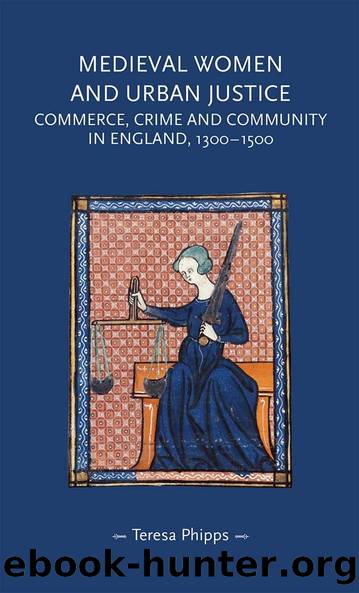Medieval women and urban justice by Teresa Phipps

Author:Teresa Phipps [Phipps, Teresa]
Language: eng
Format: epub
Tags: History, Europe, Great Britain, Norman Conquest to Late Medieval (1066-1485), Law, Legal History, Women, Medieval, Social Science, Women's Studies
ISBN: 9781526134615
Google: cOveDwAAQBAJ
Publisher: Manchester University Press
Published: 2020-04-23T00:59:03+00:00
4
Violence, property and âbad speechâ: women and trespass litigation
Urban living brought with it a fair share of interpersonal conflict and violence. Town court records reveal womenâs involvement in physical and verbal assault, theft and attacks on property. When Margery Dod brought a complaint of trespass to Nottinghamâs borough court in April 1324 against Robert de Spondon, his wife Hawise and daughter Alice, the list of alleged transgressions committed against her was long and detailed. She said that they had assaulted her in the townâs Saturday market place, called her false, a thief and a whore, and accused her of stealing a tabard. As well as defaming her with these accusations, they also beat, crushed and dragged her on the floor. Margery sought damages of 20s in compensation for the attack.1 Though the outcome of this suit is not known, it serves to demonstrate the range of physical and attacks that the plea of trespass could encapsulate, as well as the ways that members of the urban community (allegedly) caused harm to one another. In addition, trespass pleas allowed townspeople to defend their rights over property, goods and chattels, in which both financial prosperity and social status were vested. In Winchester in January 1386, Johanna Burbache complained that William Crowk, a chaplain, attacked her with force and arms using sticks and knives, entering her house against her will and stealing goods and chattels to the value of £6. Burbache claimed damages of £10 for the injury and harm she experienced, though the jury awarded only £6 3s.2 These complaints were not simply about the direct financial loss that they caused, but the resultant damage to an individualâs honour and reputation. The public nature of borough court litigation offered an ideal forum in which to voice these grievances and seek retribution.
This chapter examines womenâs roles in a wide range of interpersonal offences, recorded in pleas of trespass, and the representation of these offences under local law. It considers both the nature of these misdeeds as well as the choices of litigants to bring these issues to light in court and the way that these complaints were dealt with. Trespass litigation provided for the public voicing of complaints about misbehaviour and acted as a mechanism to rebuild damaged honour and reputation.3 The claiming of monetary damages also allowed for quantification of the harm caused by trespasses, somewhat in common with the âblame and claimâ compensation culture of the twenty-first century. While criminal pleas, reserved for the central courts, represent the most severe and exceptional acts of violence and wrongdoing, trespass pleas allow us to access the more âordinaryâ misbehaviour that was a constant feature of town life. As Patricia Turning has argued for medieval southern France, the records of crime and misbehaviour, though constructed by men and often appearing to be dominated by menâs transgressions, offer clues about womenâs day-to-day concerns and experiences of urban life, as well as the strategies they employed to fight âfor power and placement within the social hierarchyâ.4
Download
This site does not store any files on its server. We only index and link to content provided by other sites. Please contact the content providers to delete copyright contents if any and email us, we'll remove relevant links or contents immediately.
Room 212 by Kate Stewart(4123)
The Crown by Robert Lacey(4122)
Endurance: Shackleton's Incredible Voyage by Alfred Lansing(3859)
The Iron Duke by The Iron Duke(3657)
The Rape of Nanking by Iris Chang(3531)
Killing England by Bill O'Reilly(3469)
Joan of Arc by Mary Gordon(3272)
Say Nothing by Patrick Radden Keefe(3078)
I'll Give You the Sun by Jandy Nelson(2850)
Shadow of Night by Deborah Harkness(2748)
Hitler's Monsters by Eric Kurlander(2741)
Margaret Thatcher: The Autobiography by Thatcher Margaret(2692)
Mary, Queen of Scots, and the Murder of Lord Darnley by Alison Weir(2683)
Darkest Hour by Anthony McCarten(2655)
Blood and Sand by Alex Von Tunzelmann(2616)
Red Famine: Stalin's War on Ukraine by Anne Applebaum(2473)
Eleanor & Park by Rainbow Rowell(2402)
The One Memory of Flora Banks by Emily Barr(2357)
Book of Life by Deborah Harkness(2286)
